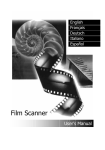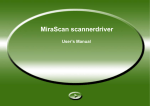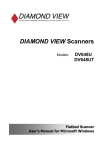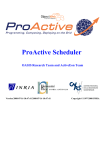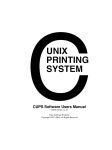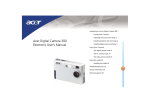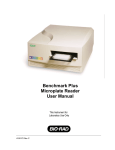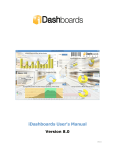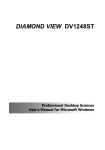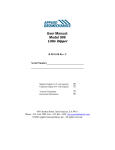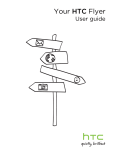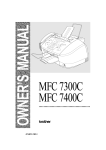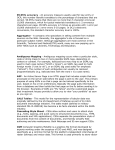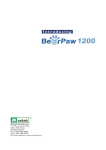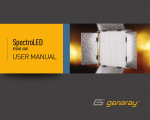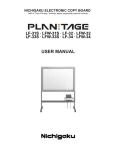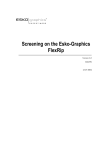Download FLATBED SCANNER - Carl McMillan.com
Transcript
Flatbed Scanner Software User’s Manual MiraScan main screen Combo Boxes (page 13) Menu Bar (page 9) Job List and Command Buttons (page 22) Tool Bar (page 24) Preview Area (page 24) Status Area (page 39) Copyright Copyright © 1999 by this company. All rights reserved. No part of this publication may be reproduced, transmitted, transcribed, stored in a retrieval system or translated into any language or computer language, in any form or by any means, electronic, mechanical, magnetic, optical, chemical, manual or otherwise, without the prior written permission of this company. Disclaimer This company makes no representations or warranties, either expressed or implied, with respect to the contents hereof and specifically disclaims any warranties, merchantability or fitness for any particular purpose. Further, this company reserves the right to revise this publication and to make changes from time to time in the contents hereof without obligation of this company to notify any person of such revision or changes. Brands and product names are trademarks or registered trademarks of their respective companies. IMPORTANT SAFETY INSTRUCTIONS 1. Read these instructions carefully. Save these instructions for future reference. 2. Follow all warnings and instructions marked on the product. 3. Unplug this product from the wall outlet before cleaning. Do not use liquid cleaners or aerosol cleaners. Use a damp cloth for cleaning. 4. Do not use this product near water. 5. Do not place this product on an unstable cart, stand, or table. The product may fall, causing serious damage to the product. 6. Openings in the cabinet and the bottom are provided for ventilation; to ensure reliable operation of the product and to protect it from overheating, these openings must not be blocked or covered. The openings should never be blocked by placing the product on a bed, sofa, rug, or other similar surface. This product should never be placed near or over a radiator or heat register, or in a built-in installation unless proper ventilation is provided. 7. This product should be operated from the type of power indicated on the marking label. If you are not sure of the type of power available, consult your dealer or local power company. 8. Do not allow anything to rest on the power cord. Do not locate this product where persons will walk on the cord. 9. If an extension cord is used with this product, make sure that the total ampere rating of the equipment plugged into the extension cord does not exceed the extension cord ampere rating. Also, make sure that the total rating of all products plugged into the wall outlet does not exceed the fuse rating. 10. Never push objects of any kind into this product through cabinet openings as they may touch dangerous voltage points or short out parts that could result in a fire or electric shock. Never spill liquid of any kind on the product. 11. Do not attempt to service this product yourself, as opening or removing covers may expose you to dangerous voltage points or other risks. Refer all servicing to qualified service personnel. 12. Unplug this product from the wall outlet and refer servicing to qualified service personnel under the following conditions: a. When the power cord or plug is damaged or frayed b. If liquid has been spilled into the product c. If the product has been exposed to rain or water d. If the product does not operate normally when the operating instructions are followed. Adjust only those controls that are covered by the operating instructions since improper adjustment of other controls may result in damage and will often require extensive work by a qualified technician to restore the product to normal condition. e. If the product has been dropped or the cabinet has been damaged f. If the product exhibits a distinct change in performance, indicating a need for service. 13. Use only the power cord or power adapter which is of the same type as the one originally included with the scanner. FCC INFORMATION The Federal Communication Commission Radio Frequency Interference Statement includes the following paragraph: This equipment has been tested and found to comply with the limits for a Class B Digital Device, pursuant to Part 15 of the FCC Rules. These limits are designed to provide reasonable protection against harmful interference in a residential installation. This equipment generates, uses and can radiate radio frequency energy and, if not installed and used in accordance with the instruction, may cause harmful interference to radio communication. However, there is no guarantee that interference will not occur in a particular installation. If this equipment dose cause harmful interference to radio or television reception, which can be determined by turning the equipment off and on, the user is encouraged to try to correct the interference by one or more of the following measures: 1. 2. 3. 4. Reorient or relocate the receiving antenna. Increase the separation between the equipment and receiver. Connect the equipment into an outlet on a circuit different from that to which the receiver is connected. Consult the dealer or an experienced radio/TV technician for help. The user should not modify or change this equipment without written approval from this company. Modification could void authority to use this equipment. Table of Contents CHAPTER 1. MIRASCAN............................................................................ 1 PREFACE: INTRODUCTION TO MIRASCAN .............................................................. 1 SCANNING REFLECTIVE AND TRANSPARENT ORIGINALS ............................................... 4 Scanning reflective originals .................................................................... 4 Scanning transparent originals................................................................. 6 UNDERSTANDING MIRASCAN FUNCTIONS .............................................................. 9 Menu Bar ............................................................................................. 9 File submenu ..................................................................................... 9 Settings submenu............................................................................. 10 Help submenu.................................................................................. 12 Combo Boxes...................................................................................... 13 Original box..................................................................................... 13 Image Type box............................................................................... 14 Scan Mode box ................................................................................ 15 Resolution box ................................................................................. 15 Scenarios for using a high resolution scan............................................ 16 Scaling box...................................................................................... 17 Filter box ........................................................................................ 17 Descreen box................................................................................... 19 Color Wizard box .............................................................................. 20 Job List and Command Buttons.............................................................. 22 Job List ........................................................................................... 22 Duplicate button............................................................................... 23 Info button...................................................................................... 23 Delete button................................................................................... 23 Preview button................................................................................. 23 Scan button..................................................................................... 23 Exit button ...................................................................................... 23 Preview Area ...................................................................................... 24 Tool Bar ............................................................................................. 24 Selection button ............................................................................... 24 New Frame button............................................................................ 25 Hand button .................................................................................... 25 Zoom button.................................................................................... 25 Level button .................................................................................... 26 Curve button ................................................................................... 30 Color Balance button......................................................................... 32 Color Adjustment button.................................................................... 33 Brightness/Contrast button ................................................................ 34 Threshold button.............................................................................. 35 Invert button ................................................................................... 36 Mirror button ................................................................................... 36 Rotate button .................................................................................. 37 i Auto button ..................................................................................... 38 Status Area......................................................................................... 39 CHAPTER 2. PHOTO EXPRESS................................................................. 41 INTRODUCTION .......................................................................................... 41 GETTING STARTED ...................................................................................... 42 GETTING IMAGES ........................................................................................ 44 Working with Album............................................................................. 44 WORKING ON IMAGES .................................................................................. 46 Adjusting Images ................................................................................ 46 SHARING IMAGES........................................................................................ 48 Printing Images................................................................................... 48 Saving Images .................................................................................... 49 EXPRESS YOUR IMAGES................................................................................. 50 Create Calendars ................................................................................. 50 Morphing Photos ................................................................................. 51 WORKING IN PROJECT MODE .......................................................................... 52 To Begin a New Project ........................................................................ 52 Working with Templates ....................................................................... 53 Adding Decoration ............................................................................... 54 Printing Templates............................................................................... 55 Sharing Templates............................................................................... 56 CHAPTER 3. TEXTBRIDGE CLASSIC ........................................................ 57 TEXTBRIDGE CLASSIC .................................................................................. 57 Main Screen........................................................................................ 57 Select Scanner .................................................................................... 58 BEGIN OCR IN AUTOMATIC MODE.................................................................... 59 CHAPTER 4. COPIER ............................................................................... 61 Adjust Copier Settings .......................................................................... 61 Copier Parameters ............................................................................ 62 How to Use Copier ............................................................................... 65 CHAPTER 5. TROUBLESHOOTING AND FAQ ............................................ 67 5.1 FAQ ................................................................................................ 67 5.2 TROUBLESHOOTING ................................................................................ 67 CHAPTER 6. SERVICE INFORMATION..................................................... 69 APPENDIX. MIRASCAN MAIN SCREEN GUIDE MAP ................................ 71 ii iii iv Chapter 1. MiraScan Preface: Introduction to MiraScan MiraScan is the driver program for your scanner. It is TWAIN compliant and designed to be user-friendly. With its iconlized user interface and fully logical taskflow design, you can complete a satisfactory scanning job with only a few mouse clicks. You can perform all of the following tasks using MiraScan: 1. 2. 3. 4. 5. Preview, scan and import the reflective originals or transparencies into your image editing software. Adjust the quality of your scanned image before you actually start editing the image in your image editing software. Apply batch scan functionality, allowing you to specify and switch among multiple scanning sessions in an image. Create special effects to the scanned image by applying Invert and Mirror functions. Use the Color Wizard to adjust the image easily and quickly. 1 MiraScan Main Screen You can open the MiraScan driver using your image editing or OCR (optical character recognition) software. Depending on the software you use, you may need to select the scanner (image source) before you can use the scanner and MiraScan to scan and import image. For details, please refer to the instructions that come with your particular software package. When MiraScan is evoked successfully, the following main screen will appear: Combo Boxes Menu Bar Tool Bar Job List and Command Buttons Preview Area 2 Status Area Main Screen Feature Menu Bar Combo Boxes Preview Area Tool Bar Status Area Command Button and Job List Used to… Adjust MiraScan settings and display driver information. Specify different scan settings and apply to the scanned image, according to the original you want to scan. Preview the original image in order to obtain a general understanding of what the image will look like and adjust the scan area. Access several advanced tools in order to adjust the scanned image more precisely. Display information of current image. Manage scan jobs and control scan actions. 3 Scanning Reflective and Transparent Originals This chapter will guide you step by step toward a successful scan: Scanning reflective originals Step 1. Place the original face down on the scanner glass plate. Note the direction of the original so that you will not scan the image in the wrong direction. Close the scanner lid. Note the direction Step 2. Open your application software. Step 3. If this is your first time to scan, you may have to select the TWAIN source by choosing Select source in the File menu and then selecting MiraScan in your application software (You only need to do this once, unless you re-install your application software). Please note that the way to select the TWAIN source may differ according to the software you use. For details, please refer to the documents that come with your application software. Step 4. Choose Acquire from your application software to bring up MiraScan (this may also differ according to the application you use). Step 5. From the MiraScan main screen, select Reflective in the Original combo box, then click Preview. A preview image will appear in the Preview Area. Step 6. Adjust the scan area in the Preview Area. Step 7. Use the options in the Combo Boxes to specify the Resolution, Scale…, etc. that will apply to the scanned image. Step 8. Use the options in the Tool Bar to adjust the image. 4 Step 9. If you need to add another scan area (scan job) to the original, push the Duplicate button in the Job List to add a new job. Then repeat Step 6 and 7 to do the settings for that scan job. Click this button to add a new job. Step 10. After you have finished with the settings for each scan job, press the Scan button to scan. Step 11. A few seconds later, the scanned image(s) will be imported into your application software. You can start to edit the image(s). 5 Scanning transparent originals Note: your scanner must be equipped with a TPO to scan transparent originals. Remove the optical cover from the TPO before scanning. Step 1. Place your film in an appropriate film frame, then place on the glass plate of scanner. When doing so, make sure that the calibration area is facing the right direction (Towards the front panel of the scanner). Do not block the calibration area, or the scanner will fail to function correctly. Calibration area Transparency positioning frame Note the direction of the calibration area Scan Negative Films Place the film with emulsion side face down 6 Scan Mounted Slides Slide holder Scan Filmstrip Filmstrip holder Insert the filmstrip into the holder Step 2. Open your application software. Step 3. If this is your first time to scan, you may have to select the TWAIN source by choosing Select source in the File menu, then selecting MiraScan in your application software (you only need to do this once, unless you re-install your application software). Please note that the way to select the TWAIN source may differ according to the software 7 you use. For details, please refer to the documents that come with your application software. Step 4. Choose Acquire from your application software. This will bring up the MiraScan main screen. Step 5. From the MiraScan main screen, select Transparent (if you are scanning a positive film) or Negative Film (if you are scanning a negative film) in the Original combo box. When the Film Type dialog box appears, select the type of film you use from the list and click OK. Step 6. Click Preview. The preview image will appear in the Preview Area. Step 7. Adjust the scan area in the Preview Area. Step 8. Use the options in the Combo Boxes to specify the Resolution, Scale…, etc. that will apply to the scanned image. Step 9. Use the options in the Tool Bar to adjust the image. Step 10. If you need to add another scan area (scan job) to the original, click on the Duplicate button in the Job List to add a new job. Then repeat Steps 7 through 9 to adjust the settings for that scan job. Click this button to add a new scan job. Step 11. After you have finished with the settings for each scan job, click on the Scan button to scan. Step 12. A few seconds later, the scanned image(s) will be imported into your application software. You can start to edit the image(s). 8 Understanding MiraScan Functions This section describes all the features provided by MiraScan. By fully utilizing these features, you can scan images more efficiently and quickly. Menu Bar There are three selectable menu items in the Menu Bar. Each menu item contains several options in its submenu: File submenu MiraScan can record the settings you make for each scan session in a configuration file. With this feature, you can specify different settings for each scan job in each configuration file. Load the configuration file when you want to apply the settings. For example, you can save the settings you make for scanning magazine pictures in a configuration file and name it “Magazine”. The next time you want to scan a magazine picture, you can load the “Magazine” configuration file and MiraScan will apply the settings recorded in it. Load Config… Load the configuration file you created. When the configuration file is loaded successfully, MiraScan will apply the settings recorded in the configuration file automatically. Save Config… Save current MiraScan settings into the configuration file. Save Config As… Save current MiraScan Settings as another new configuration file. Usually you can create a new configuration file in this way. You can designate different file names for each configuration file. Reset Config When you select this item, the settings you make in MiraScan will be reset to its default value. Auto Save Config When you select this item, the settings will be saved in a configuration file automatically as you exit MiraScan. 9 Settings submenu You can adjust several general scan settings in this submenu. Scan Size… When you choose this item, the following dialog box will appear: In this dialog box, you can set the sizes of the areas to be scanned. First, choose the job number (the numbers of the scan areas listed in the Job List) from the job number list box, then set the size of the scan area. Click in the Scan Size list box: If you have set the original as Reflective (Flatbed) in the Combo Boxes, you can choose the scan area size from the list. Four frequently used formats are listed: A4, A5, B5 and Letter. You can also customize the scan sizes by choosing Custom in the list box and then enter the desired width and height into the Width and Height text boxes. The default unit is inch. To change the unit, press in the list box with your mouse, and choose the desired unit from the list by clicking it. If you have set the original as Transparent or Negative Film, the list box will contain only two items: Max. Area and Custom. Choosing Max. Area, the full range of the image will be scanned. If you choose Custom, you can enter the sizes you want into the Width (max.: 8 inches) and Height (max.: 10 inches) text boxes. After you complete your settings, click on the OK button to confirm your settings and close the dialog box. You can then press the Cancel button to close the dialog box without saving your settings; or you can press the Apply button to apply your settings to the image without closing the dialog box. 10 Monitor Gamma Generally, a monitor cannot display the real colors of an image in the real world. In order to have the monitor approximate the colors as possible, usually, you need to adjust the monitor gamma. Adjustment of the monitor gamma can make the monitor approximate the colors of the original image more closely. Choose this item, and the following dialog box will appear: From this dialog box, you can adjust the brightness in the midtone of display so that it can approximate the color details of the original images. Drag the scroll bars to adjust the gamma values of red, green, blue and gray until the monitor displays the original colors more accurately. If the Syn box is checked, you can adjust all the four gamma values simultaneously by dragging any scroll bar. When the adjustment is done, press the OK button to confirm your settings and close the dialog box; otherwise, press the Cancel button to cancel your settings and close this dialog box. If you use the default value, click on the Default button and MiraScan will set the gamma value to 1.4. 11 Film Type This item is applicable only if you are scanning negative films and your scanner is equipped with TPO. Choosing this item, the following dialog box will appear: When you want to scan a negative film, choose the type of your film here in advance. MiraScan will optimize the scanning result for the film type you selected. If you do not know the type of your film or your film type is not listed, choose Generic from the list. When the selection is done, click OK to confirm or Cancel to abort. Auto Preview To perform the preview operation automatically each time you open MiraScan, check the Auto Preview checkbox. Help submenu Click on the Help submenu, if you are either not clear about certain MiraScan functions, or if you want information about MiraScan or your scanner. Contents Click this item to bring up the on-line help system for your MiraScan. Before you can use the on-line help system, you will need to have an Internet browser (such as Netscape Navigator or Microsoft Internet Explorer) installed in your computer. Scanner Info… Select this item and a dialog box showing the scanner and driver information will appear. This information, especially the driver version, is useful when you call for technical support or if you plan to update your MiraScan scanner driver. About MiraScan… Choose this item to display the MiraScan copyright information. Click on the image to close it. 12 Combo Boxes Combo Boxes provide several options to adjust the scan settings before you scan an image. In order to achieve the best scan result, you may need to adjust the settings according to the purpose of the scanned image and the type of original you use to scan. Original box According to the type of original you use to scan, you can select the original type from this box. There are three items available on the list: Reflective (Flatbed) Select Reflective (Flatbed) if you are scanning images on hard copies, such as magazine pictures, photographs or paper documents. Transparent Select Transparent if you are scanning positive films or slides. Please note that this function is only applicable if your scanner is equipped with a TPO. Negative Film Select Negative Film if you are scanning negative films (such as the 35mm film used for cameras). The following dialog box will appear to select the appropriate film type. Choose the film type according to the film you use to scan. If you do not know the film type or if the film type is not on the list, please select Generic. This function is applicable only if your scanner is equipped with a TPO. 13 Image Type box Color (RGB) The Image Type box is used to select a particular data type for your scanning. You will need to select a correct image type according to the original and the purpose of the scanned image. For example, if you are scanning a text document, choose Line Art instead of Color to fit the original type save the file size. The effect of each item is described below. Each pixel of a color image occupies 24 or 36 bits (according to your selection in the Scan Mode box). The Color mode is used for scanning images with continuous tones of gray shades or colors that must be kept (such as a photograph). It contains more information than other image types and may require excessive system memory. Note: if you select Color (RGB) as the image type, the “Threshold” function in Tool Buttons will be disabled automatically. Gray Each pixel of a gray image occupies 8 bits. A total of 256 gray levels may be represented. The Gray mode is used mainly for scanning grayscale images. Note: if you select Gray as the image type, the “Color Balance”, “Color Adjustment”, Threshold” and “Rotate” functions in Tool Buttons will be disabled automatically. Line Art Each pixel of a Line Art image occupies 1 bit. A total of 2 gray levels, i.e., black and white, may be represented. The Line Art mode is used for scanning documents or graphics containing lines, text and detailed drawings. Select this item if you are scanning for an OCR (Optical Character Recognition) process, and keep the resolution at or above 300 dpi. Note: if you select Line Art as the image type, the following functions will be disabled automatically: “Descreen”, “Filter” and “Color Wizard” in Combo Boxes. “Level”, “Curve”, Color Balance”, Color Adjustment”, “Brightness/Contrast” and “Rotate” in Tool Buttons. 14 Scan Mode box The Scan Mode box provides two scan modes: High Speed and High Quality. High Speed In High Speed mode, MiraScan scans image at a higher speed. High Quality In High Quality mode, the scanned image retains higher quality. Resolution box Resolution is used to decide how delicate the scanner captures the original image. When the original is scanned and turned into a digital image, the scanner captures and records the image in terms of pixels. The more pixels used to record an image, the more delicate it seems. In this way, details in the image may be represented more clearly. Resolution is the density of pixels in a digital image and is usually measured by a unit called dpi (dot per inch). If you use higher resolution to scan an image, the scanner will record the image with more pixels and the quality of the scanned image improved. Below are two examples of one image scanned at different resolutions: Image scanned at 150 dpi Image scanned at 300 dpi The best way to select the scan resolution is to match the purpose of your scan job. This is because the higher resolution you use for scanning, the larger the scanned image file size will become. When resolution is elevated cross a certain 15 value, it will only enlarge the file size of the scanned image without improving the image quality. If you are scanning images for displaying on screens, such as web page images, a resolution of 75dpi is sufficient. If you are scanning images for printer output, we recommend that you use a resolution of no more than 300dpi. Scenarios for using a high resolution scan High resolution scans are not normally used for our ordinary purposes. However, they may be of use when professionals need to retain the sharpness and overall quality of images. Select a resolution (ranging from 75dpi to 19200dpi) from the Resolution box. Alternatively, you may select Custom… to customize resolution. Once you select Custom…, the following dialog box will appear: From this dialog box, drag the scroll bars to adjust the resolution of the X (Horizontal) and Y (Vertical) axis independently. This may however, cause the resolution of the X-axis to be different from that of the Y-axis. Consequently, the shape of the original image will be altered. To avoid this, you may check the Sync check box to adjust the resolutions of the X- and Yaxes simultaneously. This will constrain the proportions of the original image. When you get the desired effect, click on the OK button to confirm your settings and close the dialog box. If you are not satisfied with the adjustment, click on the Cancel button to cancel your settings and close the dialog box. 16 Scaling box The scaling combo box allows you to specify the horizontal and vertical scale of the image to be scanned. Note that the maximum and minimum scaling is determined by the resolution. The scaling unit is a percentage (%). You may select a scaling percentage from the list. The value selected applies to the horizontal and vertical coordinates. To customize the scale, you may select the Custom... item to open the Custom Scaling dialog box shown below: From this dialog box, you can adjust the scales of the X (Horizontal) and Y (Vertical) axis independently by dragging the scroll bars. This may cause the scale of the X-axis to be different from that of the Y-axis. Consequently, the shape of the original image will be altered. To avoid this, you can check the Sync check box to adjust the scales of the X- and Y-axis simultaneously. This will retain the original shape of the image. When you get the desired effect, click on the OK button to confirm your settings and close the dialog box. If you are not satisfied with the adjustment, click on the Cancel button to cancel your settings and close the dialog box. Filter box The Filter combo box allows you to sharpen or blur an image. You can choose from the list: No filter, Sharpen, Sharpen more, Blur, Blur more and Unsharp Mask…. If you want the edge of the image to be sharper, i.e., in a higher contrast against the background, select sharpen or sharpen more. If you select Blur or Blur more, the edge of the image will be blurred. If you want to adjust the sharpness more accurately, select Unsharp Mask… and the Unsharp Mask dialog box will appear: 17 From this dialog box, you can adjust the sharpness accurately. Dragging the scroll bar to the left will blur the image, and dragging the scroll bar to right will sharpen the image. You can also directly enter the desired value into the Amount entry box to change the sharpness. When you get the desired effect, click on the OK button to confirm your settings and close the dialog box. If you are not satisfied with the adjustment, click on the Cancel button to cancel your settings and close the dialog box. No filter Blur Blur more Sharpen more Sharpen 18 Descreen box If you are scanning images from magazines, newspapers or other printed materials, you will find that the scanned image appears to be covered by tiny screen patterns. To eliminate this screen pattern, you can use the options in the Descreen box. According to the original you scan, you can select from the Newspaper, Magazine or the Art Magazine form to match your need. You can also select Custom… to custom the descreen setting. When Custom… is selected, the following dialog box will appear: In this dialog box, you can adjust the descreen value manually between 50 and 200 by dragging the scroll bar to right or left, you can also directly enter the desired value in the Descreen entry box to set the descreen value. When you get the desired effect, click on the OK button to confirm your settings and close the dialog box. If you are not satisfied with the adjustment, click on the Cancel button to cancel your settings and close the dialog box. Original scanned image Apply Descreen at 133lpi 19 Color Wizard box The Color Wizard box offers three quick and convenient tools for you to adjust the overall quality of the scanned image: Auto Density Select Auto Density to optimize the density of the image automatically. Photo Magic If you select Photo Magic, the following dialog box will appear: There are three tabs in this dialog box. Each tab contains certain image enhancement options in thumbnails. You can click to select each thumbnail, and a red frame will appear around it. Meanwhile, a related description on the modification applied will appear in the lower part of the dialog box. If you find a satisfactory effect to use, click OK to exit the dialog box and apply the effect while scanning. Otherwise, click Cancel to exit the dialog box without applying the effect. Film Wizard Film wizard is a convenient tool for you to correct the color deviation that may occur when you scan negative films. The following dialogue box will appear after you choose this item: You can choose among the thumbnails for a best result to use. Click OK to apply and exit. Otherwise, click Reset to maintain the default state of the image or Cancel to abort and exit. Note: this function item appears only if you choose “Negative Film” in the Original box. 20 Color Matching The color matching function allows you to maintain the consistency of color reproduction between the scanner and other output devices. Note: 1. This function item only appears when you choose “Reflective” in the Original box. 2. This function does not support Windows 95. Input Device The name of the input device (your current scanner) is shown here. Output Device You can choose an output device to use by clicking each radio button. The related information will be displayed in the Output Device Profile Info box. I you choose current printer or other devices as the output device, you need to select a color profile to use. A color profile is a file that tells a device how to manage colors so it can reproduce colors more accurately and close to the origin. These profiles are usually provided by the device manufactures or you can use certain color management software to create them. Output Intent According to the output purpose, you can select from 4 color matching methods in this drop-down list box. The table below the output intent and their meanings: Intent Absolute Colormetric Saturation Relative Colormetric Perceptual Meaning Maintain the white point. Match the colors in their nearest color in the destination gamut. Maintain saturation. Used for business charts and other situations in which undithered colors are required. Maintain colormetric match. Used for graphic designs and named colors. Maintain contrast. Used for photographs and natural images. 21 Job List and Command Buttons The Job List and Command Buttons are used to control the scan job flow while you scan images. Job List The Job List provides information on all scan jobs in process. The file size is also displayed in the list. The file size will vary according to the resolution, image type and scan size you specify. Please refer to the table below to get a general concept of file size: Line Art 2,400dpi 10,592 16,929 24,672 69,757 83,799 65,842 938 84,410 135,042 196,924 557,294 669,437 526,014 7,412 25,316 405,042 590,674 1632,256 1961,000 1540,096 22,217 Unit:KB For example, if you are scanning a 3”x5” photo in Color mode at 300dpi, the file size of the scanned image will be 3,959KB, or 3.959MB. Gray Color (24-bit) 3”x5” 4”x6” 5”x7” A4 (210x297mm) Legal (8.5”x14”) Letter (8.5”x11”) 35mm film/slide 3”x5” 4”x6” 5”x7” A4 Legal (8.5”x14”) Letter (8.5”x11”) 35mm film/slide 3”x5” 4”x6” 5”x7” A4 Legal (8.5”x14”) Letter (8.5”x11”) 35mm film/slide 75dpi 11 18 26 71 85 67 1 83 133 193 548 656 516 7 248 396 578 1,641 1,964 1,543 21 150dpi 44 69 100 278 334 263 4 331 529 772 2,181 2,620 2,059 29 990 1,584 2,310 6,534 7,850 6,168 87 300dpi 170 270 392 1,101 1,323 1,039 16 1,332 2,114 3,082 8,716 10,471 8,227 116 3,959 6,333 9,234 26,129 31,389 24,662 348 22 600dpi 670 1,068 1,553 4,379 5,261 4,133 61 5,282 8,448 12,316 34,846 41,860 32,890 465 15,829 25,323 36,926 104,497 125,532 98,632 1,390 1,200dpi 2,659 4,245 6,184 17,466 20,981 16,485 237 21,111 33,771 49,243 139,344 167,392 131,523 1,855 63,298 101,271 147,680 417,950 502,080 394,491 5,556 When you have created multiple scan jobs (see below for how to create a new scan job) in the list, you can check or uncheck the box in front of the job name to decide whether to proceed scanning that specific job(s). By selecting each scan job in the list, you can adjust different scanning settings for each scan job respectively. Duplicate button Click this button to add a new scan job. This is useful when you want to scan multiple images in one original. After you click this button, a new scan area will appear in the preview area, and the new job will appear in the Job List. You can add up to 10 scan jobs in one scan session. Info button The Info button is used to display the detailed information of selected scan job. You can first click to select the job in the Job List and then click this button to display its detailed information: You can either click OK to close this information window or click Save to save the information as a text file for your future reference. Delete button Use the Delete button to delete a scan job. First click to choose a scan job in the Job List, then click this button to delete that job. Preview button Use the Preview button to start previewing the image. Preview proceeds in color or in monochrome depending on the setting in the Image Type combo box. Scan button Use the Scan button to start scanning the image. Exit button Click on the Exit button to exit MiraScan. 23 Preview Area The Preview Area is where you can see your image in rough quality and point to a pixel to read its value. You can also set the scanning area and view an instant preview of the effects caused by parameter changes from the Image functions. There are two rulers to help you set the scanning area. To the left and top of this area, rulers are shown to give you a reference for the dimension of the image. You can change the rule unit by pressing the Unit button. "P" represents pixel; "I" represents inch, and "M" represents millimeter. Unit button The Preview Area displays the preview image that is acquired after the Preview button is selected. Also, any parameter change made to the image is instantly displayed in it. Tool Bar The Tool Bar consists of a series of useful tools that you can use to adjust the image more precisely. Selection button You can first click the Selection button and then adjust the selection area in the Preview Area. The selection area is a dotted rectangle in the Preview Area, and each selection area in an image represents a scan job. Only the part 24 of image enclosed in the selection area will be scanned and transferred into the image editing software. In order to minimize the size of the scanned image file, it is better to select and scan only the necessary part of the image with selection area. To adjust the selection area: 1. Move the selection area by pointing the mouse cursor to the selection area. When the cursor turns into a crossed arrow, click and drag your mouse to move the selection area in the Preview Area. 2. Adjust the size of selection area by moving the cursor over the edge of selection area. When the cursor turns into a double-sided arrow, click and drag your mouse to expand or shrink the selection area. New Frame button Use the New Frame button to add a new selection area to the Preview Area. (To do so, you can also use the Duplicate button in Job List). First click this button, then move the mouse cursor into the Preview Area. When the cursor becomes a cross, click and drag your mouse to create a new selection area. The new selection area (scan job) you just created will also be listed in the Job List. You can use the buttons in the Job List to delete or view detailed information of that job. Hand button The Hand button is used to move the preview image within the Preview Area. If the preview image is larger than the Preview Area, you can first click this button, move the cursor onto the preview image, then click and drag your mouse to move. Zoom button Use the Zoom button to get a closer look at the preview image. Click on the Zoom button to enlarge the preview image. When the cursor turns into a magnifier, move it over the preview image, and then click on it. You can zoom out from the image by first pressing and holding “Alt” key on your keyboard and then clicking on the preview image. 25 Level button By clicking on the Level button, the Level dialog box will appear. The Level dialog box includes several useful tools for you to check the color level information of the image and adjust the image quality. A description of each component in the dialog box and how they work to affect the image follows. Color Channel box Use the Color Channel box to select a color channel to adjust. This will allow you to adjust the histogram property of each color channel respectively. Histogram A Histogram displays the distributing status of dark and bright pixels in an image. The x-axis is divided into 256 equal portions, representing the brightness level of 0 to 255. The y-axis is used to represent the quantity of pixel in each brightness level. A comparison of two images and their histograms follows: 26 Darker images have darker pixels, therefore the bars in the left are higher than that in the right. Brighter images have brighter pixels, therefore the bars in the right are higher than that in the left. In addition, if we take a look at the two images below: Image 1 Image 2 We can see that in Image 1, there is a higher contrast between the brighter and darker part of the image. Bright and dark pixels occupy a larger portion of the total image. Therefore, in the histogram there are higher bars in the left (darker side) and right (brighter side), and in the center the bars are relatively much lower, which means that there are only a few midtone pixels in the image. In image 2, pixels in objects possess greater levels of brightness and darkness. The distribution is more even than that in Image 1 as well. Therefore, the brighter, midtone and darker pixels share evenly the total pixels in the image. This will result in making the histogram for Image 2 appear smoother. 27 Now that we can understand the information in the histogram, the next step will be to adjust the image with histogram tools. Below the Histogram, there are three tiny triangles: Shadow Midtone Highlight Threshold Threshold By dragging these triangles, you can adjust the brightness and contrast of an image precisely. For example, if you drag the Shadow Threshold triangle to the right, the pixels with lower brightness level than the Shadow Threshold will be cut into black. This makes the image look darker. If you drag the Highlight Threshold triangle to the left, the pixels with higher brightness level than the Highlight Threshold will be turned into white. This makes the image look brighter. The Midtone triangle is used to control the brightness level of midtone pixels. Dragging the Midtone triangle to the left will increase the brightness level of midtone pixels and make the midtone area of image look brighter. Dragging the triangle to the right will decrease the brightness level of midtone pixels and make the midtone area of image look darker. Below is an example of using the histogram tools to enhance the image and add detail: Before adjustment After adjustment 28 Input Level box The Input Level box displays the value of Shadow Threshold, Midtone and Highlight Threshold respectively. You can also input each value here directly. Output Level box The Output Level box is used to expand the output level of the image color. You can either drag the triangles below the bar or enter the value directly to adjust. If the Input Level is set as 20 to 230, then 210 (230 minus 20) color levels can be represented in the image. If you set the Output Level as 10 to 250, then the original 210 levels of color can be “expanded” to 240 levels (250 minus 10), which can enrich the color and display more details in the image. You can also click on the Auto button in the dialog box to adjust the histogram properties automatically. When you have finished with adjustments, you can click OK to apply, or click Reset to restore the default settings. To abort and exit the dialog box, click Cancel. 29 Curve button The Curve tool is used to adjust the brightness properties of midtone pixels in an image. Once you click on the Curve button, the following dialog box will appear: An introduction to each component in the dialog box and a description of how to use the Curve tool to adjust an image follows. Color Channel box Use the Color Channel box to select the color channel to be adjusted. This allows you to adjust the curve property of each color channel respectively. Tonal Map The x-axis in the Tonal Map represents the input brightness level of the pixels in an image. The y-axis represents the output brightness level of the image. By clicking and dragging the curve to change its shape, you can adjust the difference between input and output brightness level of an image without making too much modification to the dark and bright areas. If we compare the following images and their Tonal Maps: 30 The original image and its Tonal Map. The curve is straight and diagonal. Drag the curve to the left, and the mid-tone area of the image becomes brighter. Drag the curve to the right, and the mid-tone area of the image becomes darker. You can also click the curve to add new points and further change the shape of the curve: Click to add a new point. Input/Output Status Area You can read the precise input/output value here. When you have finished with adjustments, you can click OK to apply, or click Reset to restore the default settings. To abort and exit the dialog box, click Cancel. 31 Color Balance button Click the Color Balance button to evoke the Color Balance dialog box: In this dialog box, you can change the mixture of colors of an image and emphasize or diminish certain colors. A description of Color Balance components follows. Channel This is where you can select the channel to be adjusted. Adjustment Area You can drag the triangles or enter the value (from 0 to 100) in the box directly to adjust. To adjust the color balance, first, you can select the channel you want to adjust, then drag the triangles under the three color bars. In addition, you can also enter the desired values directly into the three entry boxes to the right of the color bars to adjust the color balance. As an example, if the color of the brighter area in the original you scan appears to be bluish, you can first choose Highlight as the channel, and then drag the triangle below Cyan-Red bar to the right, or drag the triangle below the Yellow-Blue bar to the left to eliminate the bluish effect. When you get the desired effect, click the OK button to confirm your settings and close the dialog box. If you are not satisfied with the adjustment, you can click on the Reset button and the settings will return to the default values. Alternatively, you can click the Cancel button to cancel your settings and close the dialog box. 32 Color Adjustment button Click the Color Adjustment button, and the Color Adjustment dialog box will appear: Color Adjustment is another convenient tool that you can use to adjust and calibrate the colors in an image. This function works much like the Color Balance tool, but it provides another way to control the property of image colors. The Color Adjustment tool uses three control items: Hue, Saturation and Lightness. Hue is a characteristic that distinguishes one color from another, while Saturation decides the intensity of a color. Lightness is used to measure the amount of brightness in a color. The lighter a color is, the higher lightness it has. Color Wheel Color Wheel is used to specify the hue and saturation of the color you want to use. Move your mouse cursor on the Color Wheel and then click on it. Drag within the Color Wheel to select the hue of the color you want to use. The distance from the center of the wheel decides the saturation of the color: the farther you drag your mouse cursor from the center of the Color Wheel, the higher the saturation. Lightness Bar You can drag the triangle below the Lightness Bar to adjust the lightness of the color you choose. To increase the lightness, drag the triangle to the right. Otherwise, drag the triangle to the left to reduce the lightness. Entry Box While you drag within the Color Wheel to choose the hue and saturation of color or drag the triangle below the Lightness Bar to specify the lightness of color, the related information will also be shown in the Entry Boxes. You can also enter the values here directly. 33 When you have finished with adjustments, click the OK button to confirm your settings and close the dialog box. If you are not satisfied with the adjustments, you can click the Reset button and the settings will return to the default. Alternatively, you can click the Cancel button to cancel and close the dialog box. Brightness/Contrast button Click the Brightness/Contrast button and the Brightness/Contrast dialog box will appear: You can adjust the overall brightness and contrast of the image manually or automatically in this dialog box. To adjust the brightness and contrast more precisely, you can use the Curve and Level function. Brightness control Contrast control You can drag the triangle below the bar to increase/decrease the overall brightness of the image, or click Auto button to adjust the brightness automatically. You can drag the triangle below the bar to increase/decrease the overall contrast of the image, or click Auto button to adjust the contrast automatically. When you have finished with adjustments, click the OK button to confirm your settings and close the dialog box. If you are not satisfied with the adjustments, you can click the Reset button and the settings will return to the default. Alternatively, you can click the Cancel button to cancel and close the dialog box. 34 Threshold button Threshold function is very useful when you scan line art images or scan documents for OCR (optical character recognition) use. You may use this function to adjust the quality of line art images or eliminate unwanted dots in the document to improve the accuracy of recognition. Note: this function is only applicable when you select LineArt as the Image Type. Select the Threshold button, and the Threshold dialog box will appear: The x-axis in the histogram represents the brightness level of the pixels in the image (from 0 to 255, from left to right). The y-axis represents the quantity of pixels. To adjust the threshold value, drag the triangle below the histogram or enter the threshold value in the Threshold entry box directly. For example: Image 1 Image 2 35 Image 1 is the original scanned image, while in Image 2 the threshold value is changed into 56. This means that pixels in the image with brightness level below 56 will all be cut into black, and those with brightness level above 56 are all turned into white. Therefore, you will find that by setting a lower threshold value, some details are lost in the new image. However, if there are many unwanted dots in an image, you can eliminate them. When you have finished with the threshold adjustment, you can click OK to confirm, or click Cancel to abort and exit the dialog box. Otherwise, you can click Reset button and the settings will return to the default 128. Invert button You can click the Invert button to get an inverted image: Image after Invert is applied Original image Mirror button You can click the Mirror button to get a mirror reflection effect on the original as if you were viewing the image in a mirror: Image after Mirror is applied Original image 36 Rotate button You can rotate the selection area easily with this button. Besides, if the original in not aligned well, you can use this function to correct the tilt. For example, if you are scanning a photo that is not aligned well: After you preview the photo, adjust the selection area to approximately encompass the photo. Then click this button to display the Rotate dialogue box: You can drag the slider to rotate the image manually or click the Auto button to let MiraScan align the image automatically. You can also enter the rotation angle in the Angle entry box directly. Original image Image aligned by clicking Auto When you have finished with the rotation, you can click OK to apply, or click Cancel to abort and exit the dialog box. Otherwise, you can click Reset button to reset the angle. Note: 1. The Auto function applies only to reflective originals with rectangular edges (e.g., photographs and films). 2. The rotation angle can be limited by the size of the selection area. 37 Auto button After you preview an image, you can press this button to open the Auto dialogue box: Auto Crop Click this button and MiraScan will crop the scan area automatically and leave only the necessary size for scanning. Auto Descreen Click this button and MiraScan will detect and apply an appropriate descreen value for scanning. Auto Type Click this button to let MiraScan detect the image and choose an appropriate image type automatically. When selection is done, you can click OK to confirm or Cancel to abort and exit. 38 Status Area Status Area provides information of the image you are working on: Pixel Display Box This box displays the color of the pixel to which the mouse cursor is pointing. Pixel Information Area The location of the pixel expressed in X, Y coordinates and the RGB values of the pixel is displayed here. Image Information Area The image information is displayed here (W = width, H = height, S = image size, A = rotation angle). 39 <Memo> 40 Chapter 2. Photo Express In this chapter you will be introduced to the fantastic world of Photo Express. Learn more about this bundled software and make your everyday life more interesting and colorful! Refer to Photo Express electronic User’s Manual in the software disc for more details on how to use its different features and functions. Introduction Welcome to Photo Express, the new cool tool for expressing your creativity with pictures of your family and friends! Photo Express is the ultimate tool for adding that extra spark of life to your photos - it gives you the power to take ordinary, everyday pictures and turn them into high-quality works of art. With its guided workflow and intuitive interface, you’ll be printing out personalized birthday cards, calendars, and posters in no time at all! Photo Express brings a whole new attitude to photo editing. With its professionalquality templates and easy-to-use editing and management tools added to an all new interface, photo editing has never been easier or this much fun. High-end tools in a home environment put the power of a photo studio right at your fingertips. Realistic paint tools turn any scene into a work Repair cherished pictures with powerful touch-up and clone tools. of art. Organize and manage all your digitized photographs with Album. Keeping track of your loved ones has never been easier. Use templates to create outstanding calendars, birthday cards, greeting cards, invitations, and much, much more! 41 Getting Started To run Photo Express, double click the Photo Express icon on your Windows desktop or open from Windows Start Menu. When you run Photo Express, make sure that the monitor display is at a resolution of 800×600 or 1024×768 and Hi Color (15/16 bit) or True Color (24 bit) mode. The following screen will appear. It’s better to familiarize yourself with the components in the interface before you actually start: Tool Bar Mode Tabs Workspace Command Panel Options Panel Global Viewer & Thumbnail Scroll Shortcut Bar 42 Mode Tab: The Mode tabs switch Photo Express between Photo mode and Project mode. Photo mode is where the majority of your work is done, while the Project mode lets you make greeting cards, name cards, and other fun things based on templates. Command Panel: The Command panel lists all of the available categories in Photo Express necessary for getting the most out of your creativity when working on photos. Each category contains a specific set of tools. Options Panel: The Options panel shows you all the different options available for any given tool. Tool Bar: The Toolbar contains all of the tools you need to edit your photos. Each group of tools is divided into categories when you select a new category, the tools on the Toolbar change accordingly. Categories can be selected from the Command panel. Shortcut Bar: The Shortcut bar makes available to you all the most commonly used menu commands. These commands vary depending on the Command panel category you are currently in. Click the green arrow to hide the Shortcut bar. Thumbnail scroll: The Thumbnail scroll opens from the Global Viewer and lists all the images you currently have open with the topmost image displayed in the window below the Command panel. Workspace: The Workspace is where your photo is placed as you work on it. 43 Getting Images The first thing you want to do when you start Photo Express is to get the photos you want to work with into the actual program. The place you start is with Album. From here, you can do almost anything in Photo Express. All other ways of getting photos can work independently of Album, but they are also set up to let you capture or open images directly to it. Note: The Project tab only allows you to open Project Template files (*.tpx and *.tpl). For information on adding photos and other images to the template, please see Working with Templates. Working with Album Album lets you organize the photos in your computer into convenient “books” similar to real-world photo albums. These books contain thumbnails of all the images you select to put in them, as well as links to said images, information, and annotations. This way, you have instant access to all your photos from directly within Photo Express. Organize photos by author, subject, title and catalog. To create a new Album: 1. Click the Get category button on the Command Panel. 2. Select Album from the Toolbar. 3. Click the New button in the Options panel. The New Photo Album dialog box opens and you can set up the new album file. 44 To add new images to an album: 1. Select an album. 2. Click the File icon and browse for the folder where the images are stored. 3. When they appear in the Options panel, click the Select All button (or select images individually by holding down the Ctrl key as you click them). 4. Next, select the Save to album option and click the Insert button. The files are added to the last album you had open. To relink “lost” images, right-click over the album in the Options panel and select either Relink or Refresh. Printing album thumbnails: 1. Click the Album icon on the Get toolbar and then choose an album from the Options panel. 2. Press the Ctrl key, and in the workspace, click the thumbnails you want to use. The selected thumbnails are highlighted in green. 3. Click the Print button on the Command panel and select a print method. You can jump immediately to the Print option you want to use by hovering your pointer over the Print button on the Command panel. When the submenu appears, click the Print icon you want. 45 Working on Images Adjusting Images After you have acquired an image from a scanner or digital camera, it may need some adjustments. Photo Express provides you with the perfect tool for adjusting your photos: the Transform tool. To re-align a photo: 1. After scanning the photo, open it from either Album or from File directly into the workspace if you haven’t already scanned it directly there. 2. Put your mouse over the Edit category button and select Adjust from the pop-up submenu. The Adjust tools appear on the Toolbar. 3. Click the Transform button on the Adjust toolbar. The Transform options appear in the Options panel. .To freely rotate a photo, select the spin wheel in the upper right or lower left corner of the photo and rotate into position. .To position it more accurately, enter an order of degrees in the Options panel and then click either Rotate Left or Rotate Right to implement it. .To flip the photo, click either Flip Horizontally or Flip Vertically. You can re-size an image during transformation by clicking and dragging the handles on the upper left or lower right corners. You can also move the image in the workspace by dragging it with your mouse cursor. 46 To trim your photo: 1. Click the Trim button in the Edit: Adjust category. The Trim options will open in the Options panel. 2. Select a Trim shape and then set the amount of Soft edge you want to soften the edges of the trimmed photo with. 3. Click Apply to trim the photo. Note: You can open the trimmed region in a new editing workspace by selecting the Create New Image option. To re-size your photo: 1. Click the Size button in the Edit:Adjust category. This opens the Size options in the Options panel. 2. Select either a predefined size from the Standard drop-down menu, or enter custom dimensions for the image in the User defined option. 3. Select the Keep aspect ratio button to maintain continuity between height and width as you resize. This keeps the image from getting stretched unnaturally. 4. Finally, you can define the image’s Resolution. This determines how the image prints on paper - the lower the resolution, the less pixels used to generate the image, while a higher resolution uses more pixels to create an image with larger pixels. 5. Click Apply to resize the photo. 47 Sharing Images Printing Images Once you have put the finishing touches onto your photos, it is time to print them out. Photo Express contains numerous printing options, letting you output posters and name cards in addition to its regular printing duties. To print an image: 1. Select the image you wish to print from the Thumbnail scroll, or select an image or images from an available album. 2. Click the Print button on the Command panel. The print tools appear on the Toolbar. 3. Select a print tool to use. o Normal lets you print images normally on various different types of paper (from Letter to A4 to envelopes). o Tile resamples the image down to tile it multiple times on the page, creating custom “picture cards” or postcards. o Poster resamples the picture up, allowing you to print portions of it on separate pieces of paper effectively creating posters and banners. 4. Click Print. You can also print album thumbnails. For more on this, see Working with Album - Printing album thumbnails. 48 Saving Images After work on your photo is complete, you may want to save it. In Photo Express, you can save a photo in a variety of different image file formats. Each file format has its own unique properties and characteristics. Some formats, however, are better than others for specific situations, such as saving for the Web are. To save a photo: 1. Click the Share button on the Command panel. The Toolbar displays the different Share tools. 2. Click the Save button on the Toolbar. The Save options appear in the Options panel. 3. Enter the location, name, file type, and data type. 4. Select an album from the Save to album drop-down menu. 5. Click Save. o Data type describes how much color information the image is saved with. The more color information included in the file, the larger the file tends to be. The highest color data type is True Color and files saved with this data type can be very large. Indexed-256 and Grayscale each contain up to a maximum of 256 distinct colors and generally are quite small. o Some file types you can use are: BMP for saving your photos at the highest level of quality with no compression; JPEG for photos you want to use on the web or send via e-mail - it compresses photos down while retaining its overall quality; UPX for saving photos with unmerged, free-floating objects. These objects can be used again when the file is re-opened. 49 Express Your Images Create Calendars One of the easiest tasks to accomplish in Photo Express is making calendars, either for your Windows desktop or for your real desktop. They are great for keeping your loved ones close, in addition to being a convenient way to keep track of important dates in style. To create calendars: 1. Get the image you want to use as the calendar image. 2. Click the Express button on the Cmmand panel and then select the Calendar icon from the Toolbar. 3. Choose a type of calendar from the samples and modify it to fit your needs. 4. Click and drag the photo or date object to move it. Or, resize it using the control handles on the image’s border. Edit text and dates by selecting the object that contains it, then click the Planner button on the Shortcut bar to add notes or holidays to individual dates as well as add props from the Clipart box. 5. When your calendar is ready, set it as Windows wallpaper by clicking the Wallpaper icon in the Options panel, or send it to the Windows clipboard (to paste it into other applications) by clicking the Clipboard icon. Finally, print the calendar by clicking the Print button. On the Shortcut bar, click the Command Menu icon to open the Calendar Command Menu. This is where you define the properties of the calendar, such as font, colors, and text style, among other things. 50 Morphing Photos One of Photo Express’ more novel effects extras is that of image morphing. Morphing transforms an image over time to create interesting and unique “warps” of the original photo. Image morphs are output as either image sequences or animated GIF files. To morph an image: 1. Get the photo you want to morph from an album or from your hard disk. 2. Click the Express button on the Command panel. The Express extras appear on the Toolbar. 3. Select the Morph icon from the Toolbar. 4. Choose a transformation from Type. To use the transformation, move your mouse cursor into the workspace and start “painting”. 5. On the Shortcut bar, click the Add Item to Storyboard button. This adds the current image to the Storyboard. You can remove the effects of a transformation and return the image to its original state by clicking the Restore button on the Shortcut bar. Also, click the Play button to view an on-thefly rendering of the animation. 6. When your Storyboard is complete, save the file to disk by clicking the Save icon on the Shortcut bar. Note: You can output image morphs as either an image sequence or GIF animations. GIF animations are useful for putting your images on the Web while image sequences are best for searching through the individual frames to find the one that really stands out. 51 Working in Project Mode The Project mode gives you a focused environment in which to create custom greeting cards, calendars, invitations, birthday and anniversary cards, name cards, and planners. The Project mode is useful for getting through a “project” as quickly and efficiently as possible. It is where Photo Express lives up to its name, speeding you through all the necessary tasks while keeping all the unnecessary or extraneous components secure in the background. While in Project mode, you can only open template files, but you can add photo files of any image type to your templates in the process of customizing them. To Begin a New Project 1. Click the Project tab when you start Photo Express. Photo Express then switches over to Project mode, which contains slightly different options and commands than Photo mode. 2. Click the album icon on the Toolbar and then select an album from the Options panel. Albums are categorized by type, such as Flyers, Greeting Cards, and Invitations to name a few. 3. Choose a template from the album and click the Edit button on the Command panel. The template opens into the workspace. You can create your own, custom templates in Photo mode. All you need to do is set your template up (i.e. add text objects and artwork) and then save it as a *.tpx file. This file can then be opened in Project mode and saved to one of the many Project albums or added to a custom album. 52 Working with Templates Photo Express’ unique templates can be edited and customized to suit your own needs. Templates consist of multiple components, usually a combination of text and photos with a decoration or two perhaps thrown in. To change any one of these components, simply select it and choose the appropriate tools from the Toolbar. To replace images in a template: 1. Click the Edit button on the Command panel. When the submenu opens, click Place. The Place tools appear on the Toolbar. 2. Click the Album icon. 3. In the Options panel, select the image you want to insert from an available album. 4. Click Replace. You can also insert images that are already open in the workspace. Simply click the Workspace icon on the Place toolbar and select the image you want to add to the template. To move one object over another: 1. Select the object you want to move up. 2. Click the Move Object Up button on the Shortcut bar. This moves the object up one level, placing it above and over objects lower than it in the hierarchy. Use the Move Object Down button to place the object below other objects. 53 Adding Decoration One category of tools on the Edit menu in Project mode is unique to that tab: Decoration. These are special, object-based effects such as Frames, Edges and Props you can use to enhance photo objects in a project. To add special edge effects to a photo object: 1. Select a photo object. 2. Click the Decoration button on the Edit submenu of the Command panel. 3. Click the Edges icon on the Toolbar. 4. From the Edges drawer, click the Magic icon. This opens the Magic Edges options in the Options panel. 5. Select a Magic Edges preset and click Apply. You can create unique Magic Edges by clicking the Custom tab in the Magic Edges Options panel. To add frame to a photo object: 1. Select a photo object. 2. Click the Frames icon on the Toolbar. 3. Select a frame from the Options panel. 4. Click Apply. Note: You cannot apply frames to a background image. 54 Printing Templates As with Photo mode, Project mode lets you print your work when you’re finished with it. The same options available in Photo mode apply in Project mode as well. For more on printing, see 4-8 Printing Images and the online help. To print a template as name cards: 1. Click the Print button on the Command panel. 2. Select the Tile icon from the Toolbar. The Tile options appear in the Options panel. 3. Enter the number of rows and columns. This establishes how many name cards are printed per page. 4. Select your printer from the Printer name drop-down menu. 5. Select the paper size you want to use from Paper size drop-down menu. 6. Click Print. o To further define the layout of the name cards on the page, click the Options button. This opens the Layout options dialog box, giving you control over such things as X- and Y- offset, spacing, and image size, among others. o To setup your printer options, click the Printer Properties icon on the Shortcut bar. 55 Sharing Templates Sharing templates works exactly the same way as sharing photos in Photo mode. You can print, e-mail, fax, or output them to web pages. For more on these tools, see the online help and related documents. To e-mail a template: 1. Click the Share: Command panel. 2. E-mail button on the Click Send. Select your default e-mail client from the Mail client drop-down list for help on how to set it to work properly. To fax a template: 1. Click the Share: Fax button on the Command panel. 2. Set the desired Layout options. 3. Click Send. Microsoft Fax must be installed first before you can use this feature. To output a template as a Web page: 1. Click the Share: Web Page button on the Command panel. 2. Setup the web page’s parameters (i.e. number of rows and columns of the images to display per web page). 3. Select To Mail from the Destination drop-down menu. 4. Click Apply. 56 Chapter 3. TextBridge Classic TextBridge is a powerful OCR software that can turn text images into editable electronic text files. In this chapter you will be shown the way to use its basic function and some tips to OCR. Note: refer to TextBridge Classic electronic User’s Manual for more details on how to use its features and functions. TextBridge Classic Main Screen You can open TextBridge in two ways: you can open it directly from Windows taskbar, or open it from your word editing software. Refer to the steps below to open TextBridge directly from Windows taskbar. To open TextBridge from your word editing software, please refer to the electronic manual that comes with TextBridge Classic. To open TextBridge Classic from Windows Taskbar: 1. On Windows taskbar, click Start. 2. Move the mouse cursor to Programs, then TextBridge Classic. 3. Click the TextBridge Classic icon. TextBridge Classic opens and the main screen will appear as shown below: Menu Bar Main Tool Bar Process Bar View Area Status Bar 57 Select Scanner Before you start OCR with your scanner, please follow the steps below to select scanner for TextBridge Classics: 1. Click File in the Menu Bar. Choose Select Scanner in the drop-down submenu that appears. 2. Select Scanner dialogue box will pop up. Choose MiraScan Vx.xx.xx and then click OK. 58 Begin OCR in Automatic Mode Automatic Mode allows you to complete OCR through a few mouse clicks. Here is how to use the OCR function in Automatic Mode. 1. Place the document original facing down on the glass plate of the scanner and then close the scanner lid. Click Auto Process button. Start dialogue box will show up. 2. Choose an appropriate Page Type and select Page Source. Select Scanner as page source, then click OK. 3. MiraScan window will pop up automatically. Set the Image Type to Line-Art and Resolution to 300dpi or higher. 59 4. Preview the document image in the MiraScan Preview Area, and select the scanning area. When done, click Scan. 5. MiraScan window will disappear and TextBridge Classic will start to recognize the scanned image. The following dialogue box will pop up when TextBridge has finished recognizing the image. To continue with another document, click More Pages. To recognize the other side of the document, click Other Side. If you want to end the OCR process, click No More to save the recognized text. 6. The following dialogue box will appear at the end of your OCR process. Select the file format for the scanned text file and click Save to save. You can open the text file later with your word editing software for further editing. The quality of your document original and the setting you apply when scanning can affect the accuracy of recognition significantly. Below are some tips to improve the accuracy of OCR: o Use clean, crisp document original. o Avoid notes, scribbles and smears in your original. You can use image editing software to remove them before you actually start to recognize the scanned image. o Avoid using fancy documents. o Align the document image if it is not aligned perfectly. o Keep the glass plate of your scanner clean. 60 Chapter 4. Copier Copier is an application software that can combine your existing scanner and printer into a copy machine and make it easier to copy images and documents. In this chapter you will be shown the way to use this convenient tool. You can use Copier to: l Scale up and down The scanned image can be diminished or enlarged within the size of the paper. l Partial copy You can specify any area in the scan preview window for copying. l Save as file The scanned image can be saved as a file. Note: refer to the Copier online help for more details on how to use Copier. Adjust Copier Settings In order to make better copies, it’s important to know how to adjust the settings in the Copier. To open Copier, click Start on Windows taskbar, move the mouse cursor over Programs, Copier and then the Copier icon. Click on it and the Copier panel will appear as shown below: 61 Copier Parameters The table below is a list of Copier parameters. Before you start to copy, adjust parameters properly to fit your purpose. Icons Icon Parameter Description Scanner driver Selects the scanner driver. To select scanner driver, click this icon until your scanner driver appears in the Information Window. Allows you to select the printer type or save the copy output as a file for future use. When you click on this Printer dialog box appears. icon, the Select the printer and paper size you want, or click on Setup to configure your printer. To save the output as a file, select . Image Type Sets the image type as Text, Color Picture and Gray Picture. To set image type, click this icon until the right image type appears in the Information Window. Default setting is Text. Copy quality Sets the copying quality as High Quality or High Speed. To copy an image quickly, choose High Speed". Otherwise, choose High Quality for better results especially if you are copying color pictures. Default setting High Quality. Reset all settings Resets all of the above parameters to their original settings. 62 Information Window The Information Window shows the current settings for the Scanner Driver, Printer, Image Type, Copy Quality and number of copies. Brightness and Contrast Brightness Sliders The sliders are used to adjust the image contrast and brightness. Drag the slider with your mouse or press the right and left arrow keys to adjust the contrast or brightness. The sliders appear in red when they are in the middle or gray elsewhere. Contrast Number of Copies Digit keys Clear key The digit keys are used to set the copy number. Valid copy number for output to printer is from 1 to 99. Press the digit keys to set the copy number and the number you set will be shown in the information box. Note: If you save the output as a file, the copy number can only be set to 1. The digit keys are ineffective. The Clear button clears the copy number and resets it to 1. 63 Buttons Start Copying button. Press this button to start copying the image to printer or file. The button changes to copying and you can press it to stop copying. while the scanner is Minimize button. Press this button to minimize the Copier panel. Exit button. Press this button to exit Copier. Preview button. Press this button to open the preview windows. This button changes to when you are in the Preview Menu. Click this button to exit Preview. Copier has two preview windows - scan preview and print preview. to scan the preview image. Press When copying, the button changes to and you can press this button to terminate scanning. See the online help for more details of the Preview functions. Ready lamp. If the indicator lamp is green, this means that the scanner is ready and you can scan the next document or image. A blinking lamp means that the scanner is busy. Help button. Press this button to open the Copier online help. 64 How to Use Copier Follow these steps to copy a document: 1. Open Copier. 2. Place the document you want to copy facing down on the scanner glass plate. Set the Copier parameters properly. 3. button to start copying. Note that when copying in under Click on the progress, this button changes to and you can click on this button to cancel copying anytime. 65 <Memo> 66 Chapter 5. Troubleshooting and FAQ 5.1 FAQ 5.1.1 Why does MiraScan display the message “Scanner is warming up” whenever I scan or preview after I change the Original type or Scan Mode setting? Answer: when you change the Original type or Scan Mode, the scanner needs to switch the lamp used for scanning and warming up is needed. 5.1.2 When I preview transparent originals, why does the color of the preview image change as I move or adjust the size of the selection rectangle in the Preview Area? Answer: when processing the image data of transparent originals, MiraScan will dynamically optimize the color according to the image enclosed in the selection rectangle. Therefore, when you move the selection rectangle or change its size, a slight color change will occur to the preview image. 5.1.3 When I scan films, why does the color sometimes deviate from that of the original? Answer: because the image data of the film is not enough for MiraScan to calibrate image color accurately. Try to use another film for scanning. 5.2 Troubleshooting 5.2.1 The scanner can not work and the screen shows “Scanner not found” instead. Make sure that the SCSI cable is connected properly to your PC and your scanner is turned on. Otherwise, turn on the scanner, then enter Windows Control Panel and click Refresh in Device Manager tab of System. 5.2.2 The Auto Crop function sometimes fails. MiraScan performs the Auto Crop function by first judging the outline of the image. If the outline of the image can not be recognized properly, MiraScan will not be able to decide the correct shape to crop. This is usually caused by image data noise and dirty glass plate. If this happens, clean the scanner glass plate with a lint-free cloth and press the TPO unit gently while scanning. 5.2.3 The TPO lamp goes out when I lift the TPO unit. Check to see if the TPO unit cable is connected firmly to the scanner. 67 5.2.4 Calibration fail occurs when I scan transparent originals. Check to see if: The slide/film frame is positioned correctly. The TPO unit is working properly. The TPO unit cable is firmly connected to the scanner. 5.2.5 TextBridge can’t work. First of all, please make sure you have chosen the right data source for TextBridge Calssic. If not, please choose the right scanner in TextBridge. Secondly, set the scanning image type to Line Art. For better recognition performance, set the driver threshold value to 128. 5.2.6 The driver sometimes show the message “SCSI card not found”, and a few minutes later, it works properly. To prevent damaging the scanner due to unstable power supply or short condition, the fuse on the SCSI card could be open for a while. During this period, the SCSI card does not function but after a few minutes, the fuse temperature cools down and the fuse recovers. You can solve this question by turning the scanner power off and turn it back on for a few minutes. 68 Chapter 6. Service Information If problems persist after you check this manual, you can contact your dealer or consult the technical service below: For driver and hardware questions, please send an e-mail (Containing detailed descriptions of the problem you come upon, the hardware and software environment of your system) to the following address: Taiwan: [email protected] USA: [email protected] Europe: [email protected] For free driver updates, product information and news release, please visit the following web addresses: http://www.acerperipherals.com.tw (Taiwan) http://www.acerperipherals.com (USA) http://www.acerperipherals.nl (Europe) For questions on using the bundled application, please consult the following web addresses: http://www.ulead.com (Photo Express) http://www.xerox.com (TextBridge) Re-packing Directions To avoid unpredictable damages during transportation, please follow these guidelines when repacking your scanner: 1. 2. 3. 4. Lock the scanner: you can find the lock on the bottom of the scanner. Use the original shipping container and packing materials for repacking. Send only the scanner and other hardware required to complete the repair. Enclose a document describing the problems you encountered. 69 <Memo> 70 Appendix. MiraScan main screen guide map (See next page) 71 MiraScan main screen guide map (continued) 72


















































































